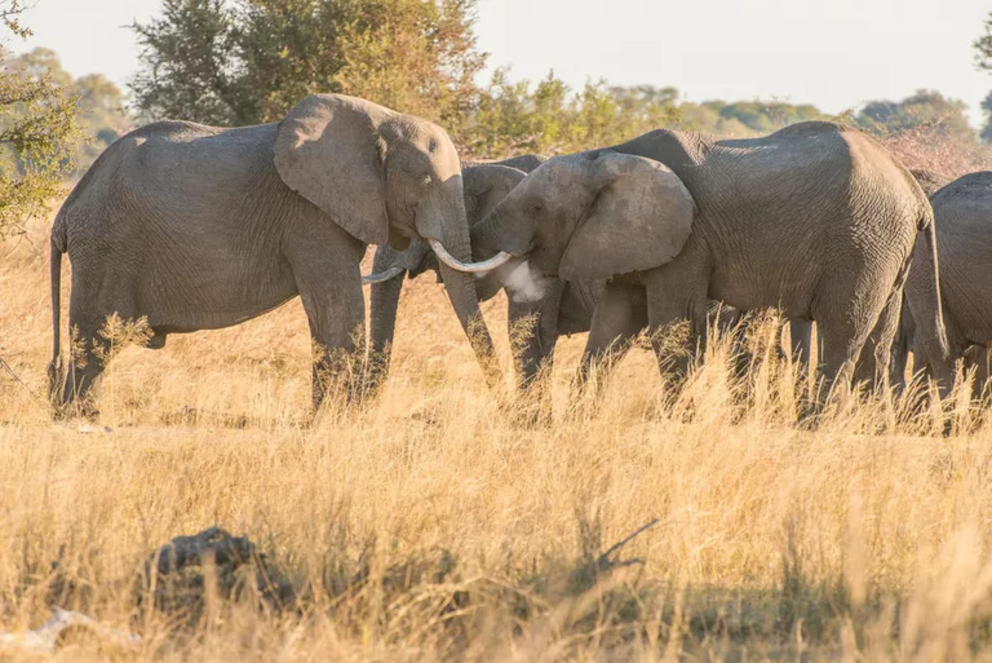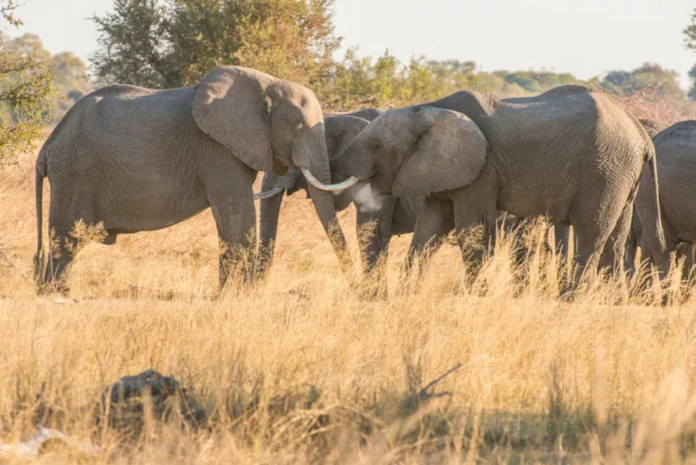
Massive aerial elephant survey is critical for conservation
The area is home to more than half of the remaining endangered savanna elephants
A huge aerial survey will count elephants in southern Africa starting next summer.
The elephant survey will be a coordinated effort by five countries in the Kavango Zambezi Transfrontier Conservation Area (KAZA TFCA). Teams from Angola, Botswana, Namibia, Zambia, and Zimbabwe will work together to carry out the first-ever concerted aerial count of savanna elephants in this key conservation zone.1
Established in 2011, KAZA encompasses 106 million acres—an area about the size of France. The five partner countries signed a treaty to create a conservation area to protect wildlife, promote tourism, and support the socioeconomic well-being of people in the region.2
The area is home to at least 220,000 elephants, which represents more than 50% of the remaining African savanna elephants (Loxodonta africana).3 The species was recently classified as endangered by the International Union for the Conservation of Nature (IUCN).4 Nearly 200 other species of mammals and more than 600 species of birds are also found in KAZA.5
Despite the importance of the elephant population, there have been no coordinated approaches to managing the animals and there has been a lack of accurate data on the population, Bas Huijbregts, African Species Director at World Wildlife Fund-US, tells Treehugger.
Recognizing that they need to work together for conservation and management reasons, the KAZA countries have agreed that the synchronized aerial survey is important to determine an accurate estimate of the animals in the area.1
Huijbregts spoke to Treehugger about the upcoming survey and why it’s so important.
Treehugger: What is the goal of the aerial survey?
Bas Huijbregts: The goal of the aerial survey is to provide the KAZA Secretariat and the Partner States with a current and reliable baseline estimate of savanna elephants in the KAZA TFCA to inform conservation planning and management decisions. Such decisions, for example, will help reduce current poaching and illegal wildlife trade through estimates of elephant carcass numbers and their distribution, thereby identifying hot spots for law enforcement action.
The spatial abundance and distribution of elephants and other wildlife will identify areas of habitat loss and competition between elephants and people for scarce resources, such as water, contributing information to large scale integrated land use planning processes and future scenarios for elephants, a further objective in the strategic elephant management planning framework.
Why is it important?
Long-term conservation of KAZA’s elephant population has suffered from the absence of coordinated elephant management approaches among the five-member countries and a lack of reliable data on this population, its abundance, range, distribution, and movements. Existing data are based on individual estimates, derived from national aerial surveys undertaken in each of the KAZA countries.
This is problematic since these country data sets cover different time periods and do not account for the entire KAZA elephant range. Due to cross-boundary movements, it is most likely some elephants might have been counted twice, and others not at all during these disparate individual country surveys.
What are the logistics? How will it work and how long will it take?
The survey will begin in July and is expected to take up to 24 months to complete, including preparations, logistics, and data analysis. The actual survey will last about 4 months, starting in July and ending in October 2022. This is the dry season when most trees and shrubs in KAZA are leafless.
Aircrafts with survey teams onboard will fly from near the center of the transboundary area and move outwards towards the periphery. Elephants will be counted using mounted cameras, GPS units and human observers onboard. Using multiple methods will allow for greater accuracy in the data collected.
What is interesting about the KAZA elephant population? Why is it so critical to assess and understand these animals?
KAZA is the most important stronghold for Africa’s remaining savannah elephants. Secondly, the long term survival of this meta-population is linked to the free movement of elephant herds across country borders of the five KAZA member states. IUCN calls for an end to poaching and to ensure that sufficient suitable habitat for both forest and savanna elephants is conserved. The population of African savanna elephants decreased by at least 60% over the last 50 years.
Both forest and savanna species have suffered sharp declines since 2008 due to a significant increase in poaching, which peaked in 2011 but continues to threaten populations. The ongoing conversion of their habitats, primarily to agricultural and other land uses, is another significant threat. Nevertheless, savanna elephant numbers have been stable or growing for decades in KAZA, which harbors the largest savanna elephant population on the continent.
The survival of these elephants depends upon their spatial and temporal movement from locally over-abundant populations in Botswana, Zimbabwe, and Namibia, to areas in Angola and Zambia where elephants have been significantly depleted due to poaching. Consequently, their management requires a coordinated transboundary approach by all five KAZA partner countries, whereby all elephants in the landscape are recognized as part of one transboundary meta-population.
Do you have any idea what you expect to find?
It is anticipated the elephant population will have been maintained either at its current level, or to have increased compared to previous country surveys, bearing in mind no KAZA wide survey has ever been undertaken before. Thus this survey importantly sets an important baseline in time. Earlier surveys were confined to individual countries and varied spatially and temporally.
In addition all other large herbivores wild and domestic will be counted, although the estimates derived for these species will be minimum estimates only due to either their size and/or cryptic nature, i.e. difficult to see from the air. Importantly the carcasses of dead elephants will also be counted, from which an estimated carcass ratio (or percentage) can be calculated. Low values indicate natural mortality only is at play whereas higher values can suggest anthropogenic factors including poaching may be having an additional impact.
How will the survey results be used to help conservation efforts?
The results from this survey will become the cornerstone for the long-term protection and management of Africa’s largest transboundary elephant population. The KAZA Secretariat will share a report of survey results with the five partner countries and use it as the basis for establishing coordinated management policies and practices. In addition, the survey could identify areas of habitat loss or competition for resources between elephants and people that inform integrated land use planning. Survey results will also serve as a benchmark for measuring future progress.
The results will furthermore also feed into, and update, the IUCN African Elephant Specialist Group (AfESG) African Elephant Database and form the basis for the development of a long-term KAZA elephant monitoring framework, which will be led by the KAZA Elephant Sub Working Group and inform the KAZA Impact Monitoring System.

